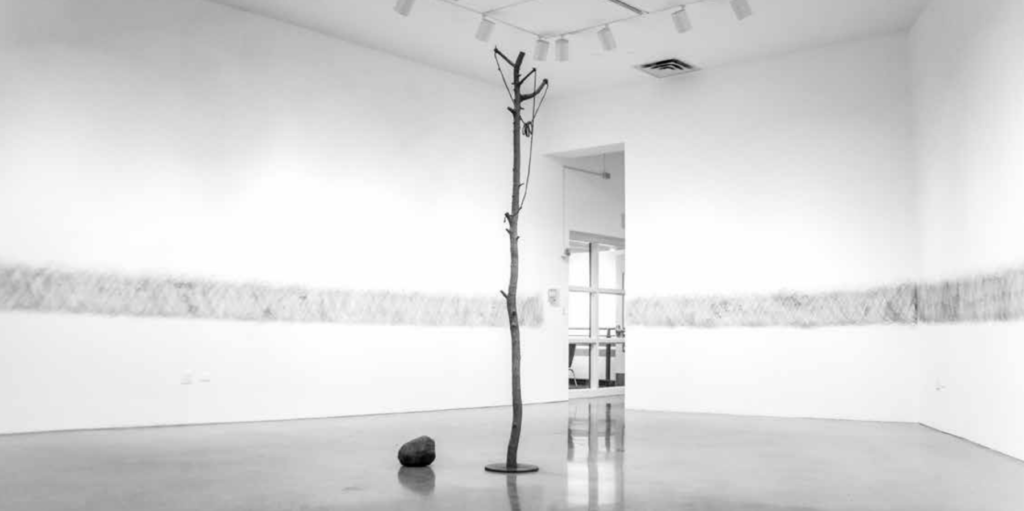Tetsuya Yamada: Untie
Review II by Forest Lewis
Denler Gallery
Oct 6–Nov 4, 2016

Tetsuya Yamada’s Walking Drawing at the Denler Gallery in St. Paul reveals how the limits of the gallery space can become claustrophobic. That Basho, the 17th century wandering poet, is quoted in the show’s press release is perhaps a little too on the nose, but in an ironic way: walking yes, wandering not so much. One wishes that the drawing, made by Yamada’s repetitive arm motion as he followed the gallery walls, would have left through the exit and wandered down the hallways and out into the suburban surrounds, covering Audis, cop cars, McDonalds, IKEA, in an endless trace of the artist’s path, restless and ceaseless.
But repetition is the key for Basho, no less than Yamada and we can imagine that Basho’s wanderings are much more determined when confined to Japan, just as Yamada’s lines are indexed by confinement: the whole world becomes irrelevant when you’re in Japan/the gallery. Or one would hope. Analogies between galleries and countries must breakdown at some point, and unless you’re starring in Lost in Translation, Japan is probably not so claustrophobic?
Despite the lofty Basho quote included for your interpretive benefit, the literary figure I was reminded of was Samuel Beckett, for being there alone in the silent, nearly empty gallery, the front desk abandoned, the drone of rain outside faintly echoing down the long hallways, it seemed like I was starring in my own version of Waiting for Godot. Waiting on a wind blasted island for whoever traced their arcs around the circuit of the room. In the middle of the room stands a very Beckettian tree, a “Ceremonial Pole,” bare of branch, and hung with some lengths and loops of waxy rope. Likewise, beside the tree sits a mundane stone, the kind you’d spend three hours of hard labor digging up from your garden only to throw it over the fence: a large, very ordinary rock.
The tree is vaguely symbolic but in no familiar way. Instead it is the axis of this gallery and the ropes are the remnants of the leash that tied the artist to this circuit. The leash has been cut and the artist, it seems, has vanished. As for the rock, a remnant of earth, pulled unceremoniously from the ground, it acts as ballast, a momento mori of the banal, a reminder that things here—in the gallery— are not too important. I like the rock; that rock, surrounded by the soon to be erased drawing, has followed me, ghost like, from the gallery to now. In that sense Walking Drawing, continuously circling that rock, may be more about the rock than the lines on the wall. The drawing becomes the planetary path, the moon cycle drawn to the rock, the banal.
So much so that the rock invalidates the pole. They are both vying to be the center in what I would argue is a meaningless contest. In which case their centeredness, their allusions to structure fades away and they become a landscape. The minimal theatre set of a barren and blasted wasteland: the terrain of Beckett.
The warmth Walking Drawing emits through its gestural human qualities is cooled considerably by the austerity of this landscape. What could have been a testimony to the habitual nature of our daily hours, the minute accumulations of incremental acts that eventually become the achievements of a life, seem here more of the continual droning of an unanswered question, a perpetual why, in which existence is a slog and death is a relief. So Beckett over Basho.
